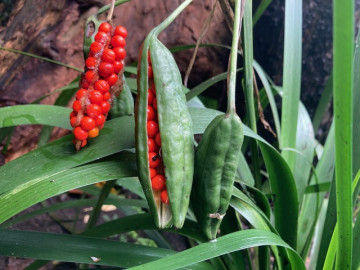![]() This page is regularly updated, please select here to view the latest version.
This page is regularly updated, please select here to view the latest version.
October 2023
STINKING IRIS
Stinking Iris (Iris foetidissima) definitely isn’t blessed with the most alluring of names, and its flowers are understated when compared with our other native iris, the Yellow Flag Iris. But this plant really comes into its own during the autumn and winter months, with its brilliant orange berries. Stinking Iris is found mostly in the south, growing mainly on calcareous soils and preferring shady situations such as woodland edge or at the base of hedgerows. Those growing at the Rec are near the pathway at the back of the play area.
 The iris grows from a rhizome which is a horizontal underground stem capable of spreading outwards to generate new roots and shoots; hence the plant is clump forming. It can reach up to 80cms high and has long strap-like, leathery leaves. The leaves are evergreen and they give rise to the plant’s official name, as well as many of its folk names. When crushed, the leaves are said to resemble the smell of beef in some form or another, and that gave rise to the alternative name of the Roast-Beef plant. As a vegan with an extremely poor sense of smell, I’ll have to leave you to determine whether it merits the appellation ‘stinking’! Another common name is Gladwin which is the Latin name for a sword, and alludes to the shape of the leaves. Interestingly, the plant was known as ‘Snakes’ Fiddles’ on the Isle of Wight, although no-one seems to know quite how the association with snakes came about.
The iris grows from a rhizome which is a horizontal underground stem capable of spreading outwards to generate new roots and shoots; hence the plant is clump forming. It can reach up to 80cms high and has long strap-like, leathery leaves. The leaves are evergreen and they give rise to the plant’s official name, as well as many of its folk names. When crushed, the leaves are said to resemble the smell of beef in some form or another, and that gave rise to the alternative name of the Roast-Beef plant. As a vegan with an extremely poor sense of smell, I’ll have to leave you to determine whether it merits the appellation ‘stinking’! Another common name is Gladwin which is the Latin name for a sword, and alludes to the shape of the leaves. Interestingly, the plant was known as ‘Snakes’ Fiddles’ on the Isle of Wight, although no-one seems to know quite how the association with snakes came about.
The flowers of the Stinking Iris appear in the late spring and early summer. They are  subtle colours with gradations of pale lilac and yellow and have attractive veining. They may not have the pizazz of the Flag Iris, but I think its nevertheless, a delicate beauty. Each flower consists of 3 sepals (looking like the larger petals) 3 actual petals which are smaller, and 3 style arms, which have the appearance of three upright, narrow petals. The style forms part of the female reproductive system and carries the pollen deposited on its tip, down to the ovary. You can see the ovary in the photograph; it’s the swollen part of the stem below the flower head that will develop into a seed capsule. The flowers themselves, are very short lived and rely on insects for pollination and seed production. So as with many plants, the Stinking Iris is covering all bases by reproducing both sexually and vegetatively.
subtle colours with gradations of pale lilac and yellow and have attractive veining. They may not have the pizazz of the Flag Iris, but I think its nevertheless, a delicate beauty. Each flower consists of 3 sepals (looking like the larger petals) 3 actual petals which are smaller, and 3 style arms, which have the appearance of three upright, narrow petals. The style forms part of the female reproductive system and carries the pollen deposited on its tip, down to the ovary. You can see the ovary in the photograph; it’s the swollen part of the stem below the flower head that will develop into a seed capsule. The flowers themselves, are very short lived and rely on insects for pollination and seed production. So as with many plants, the Stinking Iris is covering all bases by reproducing both sexually and vegetatively.
 The fertilised seed capsules swell and ripen, eventually splitting along 3 longitudinal lines, to start to disclose the brightly coloured berries inside. As the segments open fully, the berries are seen to be arranged in a neat row either side of the midrib. Although toxic to humans, they are eaten by birds, which helps in their wider dispersal.
The fertilised seed capsules swell and ripen, eventually splitting along 3 longitudinal lines, to start to disclose the brightly coloured berries inside. As the segments open fully, the berries are seen to be arranged in a neat row either side of the midrib. Although toxic to humans, they are eaten by birds, which helps in their wider dispersal.

The berries of the Stinking Iris appear in the autumn and often remain on the plant throughout the winter. Stinking, or not, this otherwise understated plant provides a welcome splash of vibrancy, at a time of year when it’s most needed.
Words snd photos by Denise Long
![]()


